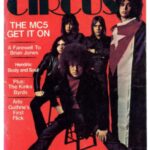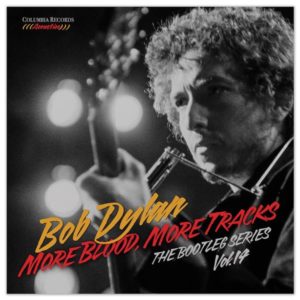-
Featured News
The MC5: A Eulogy
 By Doug Sheppard
And then there were none. Five equals zero. The morning of May 9, 2024, the last surviving member of the MC5, drummer Dennis Thompson, died while recovering from a heart attack—
By Doug Sheppard
And then there were none. Five equals zero. The morning of May 9, 2024, the last surviving member of the MC5, drummer Dennis Thompson, died while recovering from a heart attack— -
Featured Articles
The Beatles: Their Hollywood and Los Angeles Connection
 By Harvey Kubernik
JUST RELEASED are two new installments of the Beatles’ recorded history, revised editions of two compilation albums often seen as the definitive introduction to their work.
Or
By Harvey Kubernik
JUST RELEASED are two new installments of the Beatles’ recorded history, revised editions of two compilation albums often seen as the definitive introduction to their work.
Or -
Bob Dylan – More Blood, More Tracks

By Steve Matteo
Bob Dylan has spent a great deal of his career hiding behind various personas or simply just hiding, rarely giving interviews and avoiding much of the star-maker machinery behind the popular song. Yet, for decades now, Dylan has been more visible than at any time in his career. His primary work has been his ubiquitous concert touring, referred to as “the never-ending tour” since the late ‘80s. Another very visible activity was his time as DJ, hosting “Theme Time Radio” on Sirius XM, which ran from 2006 through 2009. In addition, since 1991 he has been issuing his Bootleg Series. There have been 13 separate releases, encompassing 14 volumes so far, and the latest may be one of the most anticipated. It covers his Blood on the Tracks release, and is titled More Blood, More Tracks, Vol 14 (Columbia/Legacy).
While the album is considered one of his best, it went through various incarnations before being officially released in 1975. Of the six CDs included in the deluxe edition, three tracks were released on the first official bootleg set, two were from Biograph, ten were on the official Blood on the Tracks release and one track was from the Jerry Maguire soundtrack. Also included is the first take of “Spanish is the Loving Tongue,” which Dylan covered on his 1973 self-titled album.
Blood on the Tracks was a major comeback for Dylan. After a stint with Asylum Records (Planet Waves, Before the Flood), Dylan returned to Columbia.
Dylan had recorded the album in New York, at A&R Studios, but just prior to the release date, he returned to Sound 80 Studio in Minneapolis, and re-recorded the songs. The final album included five tracks from each session.
The September 1974 New York recordings were engineered by Phil Ramone, and the myriad New York tracks here feature Dylan alone on Disc One, and the group Deliverance headed by Eric Weisberg on Disc Two. As the sessions unfold through these discs in chronological order, only bassist Tony Brown remains at the end of Disc Two. As the New York sessions progress on Disc Three, keyboardist Paul Griffin plays on many tracks and steel guitarist Buddy Cage contributes to one track. Cage also contributed to a couple of tracks on Disc Two with the Deliverance band. On Disc Four and Five it is just Dylan and Brown. Disc Six opens with the final three tracks recorded in New York.
After Dylan spent the holidays in Minnesota with his family, he had a change of heart about the sound of the album and quickly assembled a rag-tag group of musicians (Bill Berg, Billy Peterson, Peter Ostroushko, Chris Weber, Greg Inhofer, Kevin Odegard), at Sound 80 Studios in Minneapolis on December 27 with engineer Paul Martinson. While the musicians were not exactly household names at the time of the recordings, their inspired playing worked well and meshed nicely, with Brown the only holdover from the New York sessions. Berg and Peterson were hardly novices and had played key roles on recent albums from Cat Stevens and Leo Kottke.

Dylan was at a major turning point in his life, as his marriage to his wife Sara was disintegrating. He had just come off the road with The Band and he was taking art classes that had a profound effect on his songwriting process. Dylan has also acknowledged that Russian writer Anton Chekhov’s plays and short stories had a deep influence on his songwriting, which on the album featured lyrics of ever-shifting time (past, present and future) and, while seemingly autobiographical, were actually more narrative in tone.
Initial ideas for the album and recordings included the consideration of various electric music artists or electric band backing, which eventually gave way to fairly stripped-down, sparse acoustic backing by only a handful of musicians. The resultant album is an intimate, honest, thematic masterpiece that is one of the defining albums of the singer-songwriter period. The simple instrumentation provides just enough musical coloring to be more than just a folkie acoustic outing and it is Dylan’s most vocally emotive recording of his career. The album proves what Dylan is capable of when he takes his time and is deliberate in the recording studio. Often he wants to work quickly and get a fresh feel, resulting in few takes for the final recording.
The 70 recordings included here expansively chronicle a tale of two recording sessions that ultimately led to the official Blood on the Tracks release. One of the major changes in the two sessions is that the initial New York sessions tapes were sped up to sound punchier and radio friendly, but are presented here at their normal speed.
Songwriters and particularly musicians who are singer-songwriters can use this set as a master class. Dylan fans will delight in experiencing the process that led to what many consider one of Dylan’s best albums and perhaps the only recording that can rival his ‘60s three-album watershed period of Bringing it All Back Home (1965), Highway 61 Revisited (1965) and Blonde on Blonde (1966).
Along with the six CDs, the box houses a beautiful hardcover book that contains a treasure trove of memorabilia, including candid, intimate photographs, press clippings and photos of Dylan’s original lyrics, as well as many pages from a notebook he kept.